Blade Made is a circular economy strategy by Superuse where the waste flows of the wind energy sector are transformed into public furniture like seating, playgrounds, bus stops and more. This specific example shows the application of urban furniture in Rotterdam. By reusing the materials of the renewable energy production carbon emissions are reduced up to 90% compared to a standard solutions. The blades have been painted in rainbow colours to create a LHBTIQ+ monument, together with the users.
A group of citizens wanted to create a monument for sexual and gender diversity in Rotterdam. BKOR, the Municipality of Rotterdam and the initiators worked together on the development of a monument at a location where the LGBTQI+ community can meet, celebrate or commemorate respectfully and safely, individually or in small groups.
After a series of studies and campaigns, Willemsplein turned out to be the most suitable location to raise such a monument. Plans for a future redevelopment and possible greening of Willemsplein are not yet concrete. That is why it is still too early for a definitive object as a monument at this location. Superuse was asked to redesign REwind as a temporary LGBTQI+ monument.
A competition was held among artists, asking them to make a design for a new paint job for the rotor blades. Mr. June, a Dutch artist and graphic designer, won this competition and repainted the blades in his studio. His dynamic interpretation of the rainbow flag now graces the Willemsplein as a celebration of the LGBTQI+ community.
The original Blade Made Furniture for Willemsplein in Rotterdam was made in 2012, but this new layer also provides new meaning. 10 years ago the object was mainly about circularity and the fact that we can and should reuse the materials that we have. Now it is not only celebrating the diversity and quality of materials, but also the diversity of people.
In the Blade Made series we have made other outdoor furniture examples, like playgrounds, shelters for busstations, billboards and we are looking to grow into more objects in the coming years. We see opportunities in pedestrian bridges, cycling bridges, sound barriers. The end goal is that we should value the materials that we have and not recycle them before they have reached the end of their technical life.
Please highlight how the project can be exemplary in this context
The aesthetic of using "urban mining materials" / "raw material" is a new topic in architecture. There is not much literature or architecture criticism literature written about the topic yet, especially when it comes to modern design interpretations. We (as architects) are in the middle of developing an innovative language and aesthetic, we are designing it, and the Blade Made projects are an iconic example of this new language.
The reuse of waste flows is a core strategy in all our work, where this piece of furniture gave the opportunity to look at the waste provided by the renewable energy sector. The nine blades have not been cut, so they are reused as they are. Normally furniture like this would have been made out of stainless steel, plastics and/or wood. We did not need to use these virgin materials to create this object. The end result is that by reusing the wind blades we saved roughly 90% on carbon emissions compared to a regular piece of urban furniture, while it was built for the same price as a standard design. This is not an incremental step, but a huge achievement towards the goals that the EU have set for 2050.
Please highlight how the project can be exemplary in this context
We wanted to create a longlasting sculptural object that provides plenty of seating opportunities in the sun and shade. The views are directed towards the city of Rotterdam and the Erasmus bridge and towards the harbour area. The abundance of seating options make alternate uses possible. Children can play on parts of the object while parents sit quietly within sight.
To save the existing trees on the square we've developed the design to be adaptable and fold its way around them, while placing the concrete blocks far away from the roots. The furniture helps to create a lively square, but can easily be moved when necessary. The horizontal blades make for plenty of seating area while one vertical blade creates a place of high interest.
The aerodynamic wind mill blades turned out to be perfectly suitable for outdoor furniture that goes beyond the conventional. It brings a new aesthetic, since the shapes are not immediately recognisable. The Blade Made furniture sparks the imagination of adults and children and makes them realise that material can be fully functional in a new second life application.
Please highlight how the project can be exemplary in this context
We tried to enhance the feeling of togetherness by creating an embrace of seating around a quiet spot in the center of the city. The original piece was designed by Superuse and build by local contractor GKB, the same team that made the Blade Made Playground Wikado. The funding was a combination of a public contribution by the municipality and an energy company that had their main office on the square.
For the new layer of paint and new layer of meaning a collaboration has been formed with the LGBTQI+ community, municipality and the center for the arts (CBK). Together with Superuse and Mr June (David Louf) the furniture has been upgraded to a monument to celebrate sexual diversity. The idea that we could add this layer to an existing object is crucial in our way of thinking. Don't start from scratch if there are high quality materials and objects available that could fulfil the need for something new.
Please highlight how this approach can be exemplary
The combination of sustainability, aesthetics and inclusion in the project is achieved due to the integrated approach and the intrinsic qualities embedded in the process. Aesthetics come from rational design decisions in relation to the material that was given, the wind blade. Although no one would immediately say that a wind blade is a bench, the reuse of this material results in something that cannot be mistaken, it is a bench. Sustainability is at the core of the project, resulting in a carbon reduction up to 90% for Blade Made projects compared to conventional solutions. Not only has the wind blade been reused, even for the concrete blocks we had conversations with the manufacturer to replace all aggregate with recycled concrete, which was something unheard of for them. By relating the shape of the concrete blocks to the surroundings, especially the Erasmus bridge, the whole objects becomes part of the local spirit of place. This inclusion of materiality is projected towards the local community, where the LGBTQI+ could 'adopt' this piece as their monument by giving it a new layer of paint. Maintenance and inclusion come together to create a new layer of aesthetics, where we honestly see an improvement in the design. This new layer is adding new life, embedding it even more in the city fabric and thus creating something that can become part of the history and identity of the city. The ever changing and adapting city is way more beautiful than the static environment, because it can grow and people can form new connections. This is what hopefully is exemplary in this project, where we can show that it is good to build upon things that we have, instead of starting anew every time, demolishing what we don't like or don't know how to use. Reuse has history, reuse has character and by connecting local communities to your objects it becomes an example of inclusive, sustainable and beautiful design that can last for decades.
- We gave new spirit of place to an existing square that was barely used.
- We gave new meaning to an existing piece of furniture by adding another layer of diversity.
- We gave a sense of belonging for the LGBTQI+ community, that didn't have their own safe space in public.
- We created an object that celebrates diversity, not only for the LGBTQI+ community, but also for different materials in the public realm.
- The reuse of windmill blades fits in the Dutch historic context of being a windmill country, which is now manifested in a new way.
- The physical appearance of invisible waste flows as highly functional and beautiful objects helps to raise awareness and can shape future culture and acceptance of moving into a new age.
- The Blade reuse shows a solution that can be applied globally to this type of waste, by reusing the waste locally instead of transporting material all over the globe.
- The collaboration of municipality, architect, contractor, artist and local community is building local relationships. Each Blade Made object can be connected to a different local community and artist to connect their own meaning to it.
- Blade Made furniture combines sustainability, inclusion and quality of life and experience.
Please also explain the benefits that derived from their involvement.
Co-creation is at the core of the project, through all phases in time it goes through. Everything in the project is created by local stakeholders.
- The design is done by Superuse (for this project the team consisted of Césare Peeren, Jos de Krieger, Karola van Rooyen en Frank Feder, most of them inhabitants of the city). The architecture and design firm Superuse is based in Rotterdam for over 25 years.
- The initial client was the municipality of Rotterdam.
- The request for a new paint job was direct communication between Césare Peeren, inhabitant and designer, with the municipality. They saw an opportunity to combine this with the search for a local monument to celebrate sexual diversity.
- Contractor GKB is involved from engineering, building to placing and moving the furniture at times.
- The local LGBTQI+ community was involved in finding the place for their monument and the selection of the artist for the paint job.
With the Blade Made Furniture and Playgrounds we have successfully shown that;
- Reuse of rotor blades is feasible and can be beautiful. New objects in outdoor space can be made with a much smaller carbon impact (roughly 90% less) than conventional by reusing a material that would otherwise be landfilled or incinerated. This is clear transformation of material from a specific value chain that is available globally.
- Diversion of rotor blades is prolonging their lifespan and thus immediately reducing carbon emissions, while not preventing recycling in the future when this technology is available.
Beside that it is interesting to note that;
- The Blade Made playground has been checked and certified by the Keurmerkinstituut, making it a safe playground.
- Blade Made objects are flexible and modular. It can be re-designed in a completely different way in another location with other wind blades. We have proven it once in Terneuzen with a playground on the beach, but it's possible anywhere.
- Costs are comparable to other designed playgrounds, with the possibility to reduce costs when scaling. That means that Blade Made objects can be an affordable alternative to solutions that are not circular.
- The playground Wikado can be seen as the pilot project that led Superuse to discover the design potential of rotor blades and Superuse is now developing a family of urban furniture with reused rotor blades, where REwind was the first.
The decommissioning of the wind mill blades is an emerging problem worldwide and the Blade Made strategy is an innovative solution to tackle that problem. In our rough estimates for the Netherlands alone we see an increasing flow of waste coming our way towards 2030, possibly around 1800 blades per year. When we addressed this problem for the first time in 2008 ago we estimated this to be 200 blades per year. By inserting the rotor blade in a new design process their life span is extended and by staying true to their language of glass fibre reinforced polyester (GRP) we are not taking them out of a future recycling scheme.
Wind mill blades had never been reused before, they would always go to landfill or incineration after they are decommissioned, since recycling was too expensive and underdeveloped. In the past years recycling techniques are improving, but still no real solution for the blades has been found. Since then we have been making another playground, urban furniture and a bus stop out of wind blades, getting to know the material as a really versatile and durable opportunity to create interesting urban spaces. To tackle the larger amounts we are also developing new concepts to extend the range of applications for these beautifully crafted blades.
Please provide clear documentation, communication of methodology and principles in this context.
One of the main learnings is that as a society we should become better in cascading materials, turning to repair and reuse before turning to recycling. This is true for all materials, but even more so when the recycling options are really energy consuming and the afterlife not completely clear. The blades have been used by Superuse in more occasions, since we've made the first Blade Made objects.
- Blade Made playground in Rotterdam
- Blade Made playground on the beach in Terneuzen
- Blade Made seating in Rotterdam, also serving as a LGBTQI+ monument
- Blade Made shelter in Almere next to a bus station
- Blade Made art installation in Germany
- Blade Made billboard for a thrift store in Maastricht
Since Superuse has shown the potential of blades, also other parties have been doing small scale projects.
- Art installation on a festival in the Netherlands by REFUNC
- Art installation in the Netherlands by Elmo Vermeijs
- Pedestrian bridge by Anmet in Poland
- Bike shelter in Denmark by the Port of Aalborg
- Seat and billboard in Greece
These applications show that there is a potential for the reuse of blades all over Europe and it is clear that it would be good to change the perspective on waste. For most materials we have landfill bans and Europe is making the shift towards recycling and incineration. Instead we could shift to more sustainable solutions like reusing, repurposing and repairing. Blade Made can help to change the dialogue and make a mindshift happen where it becomes the normal approach to look at the potential of material and work with what you have mentality.
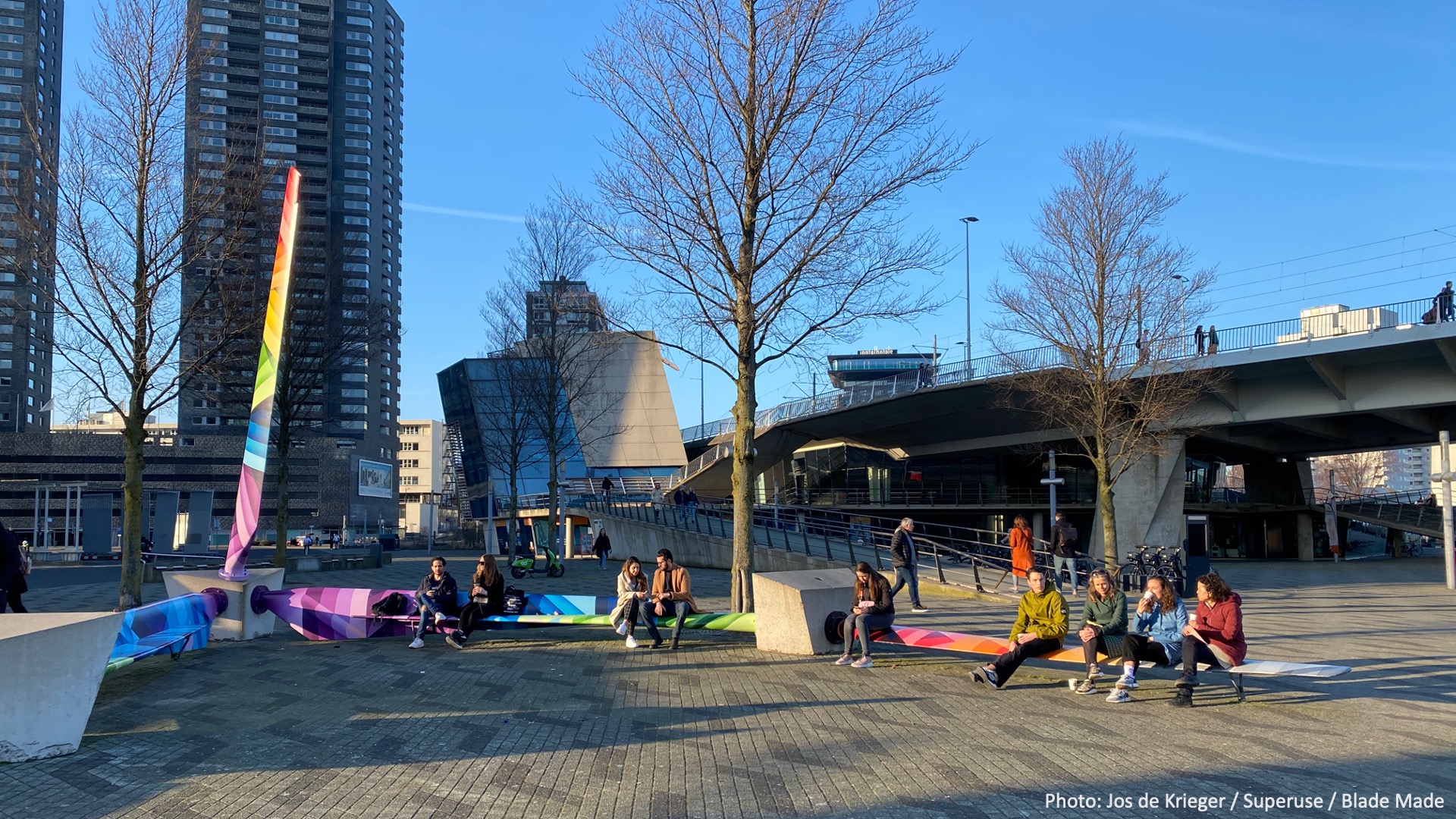
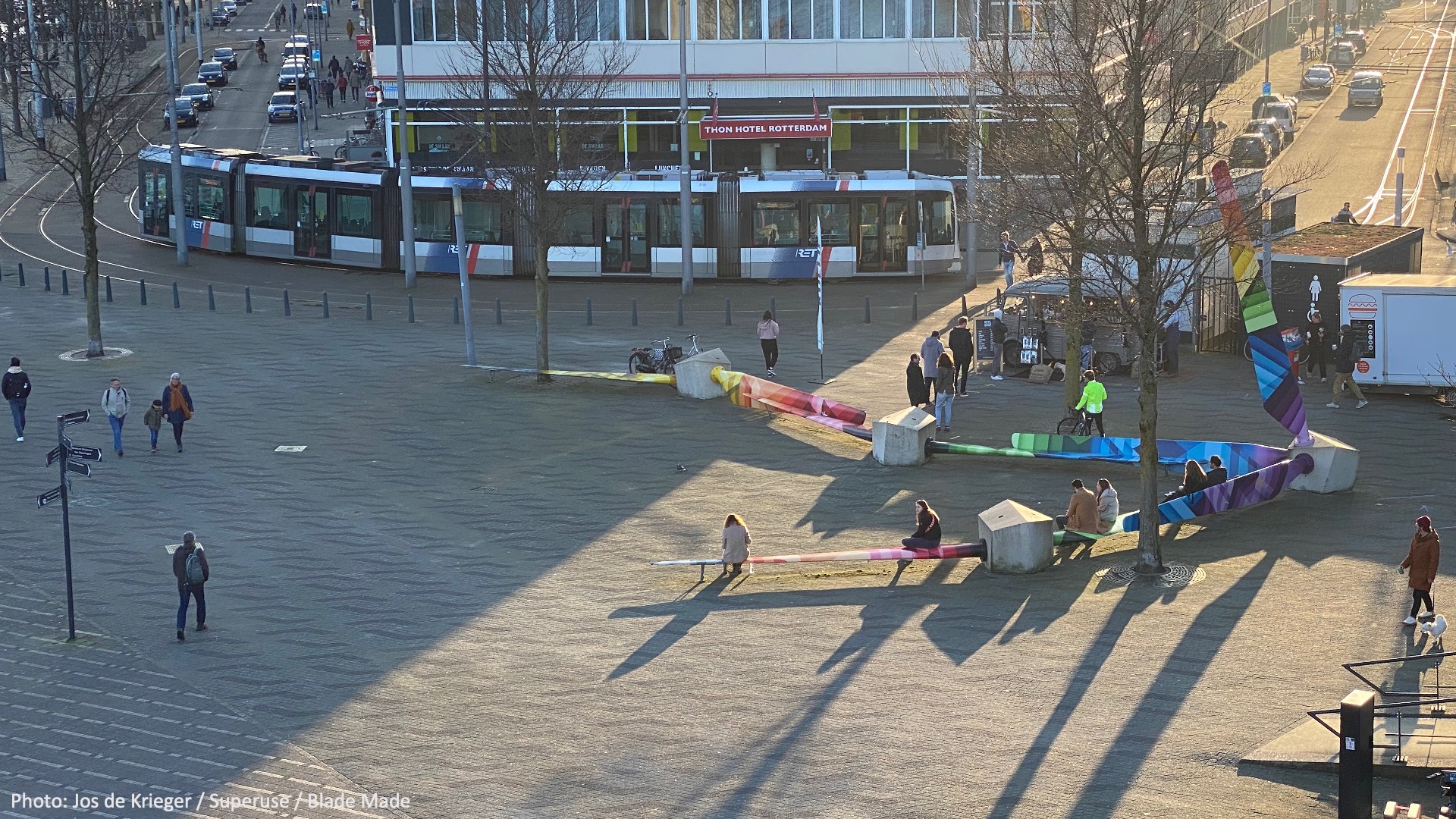
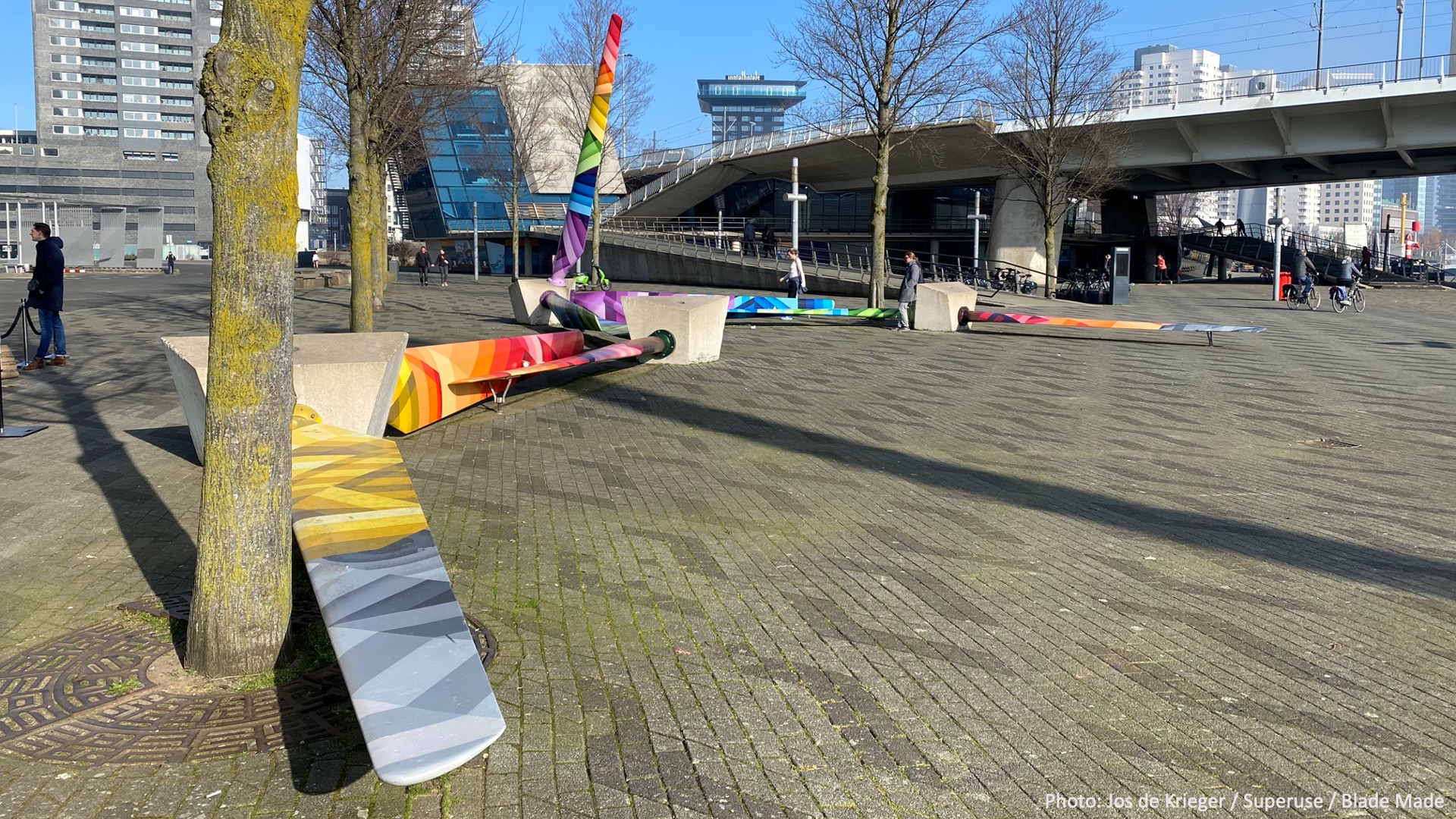
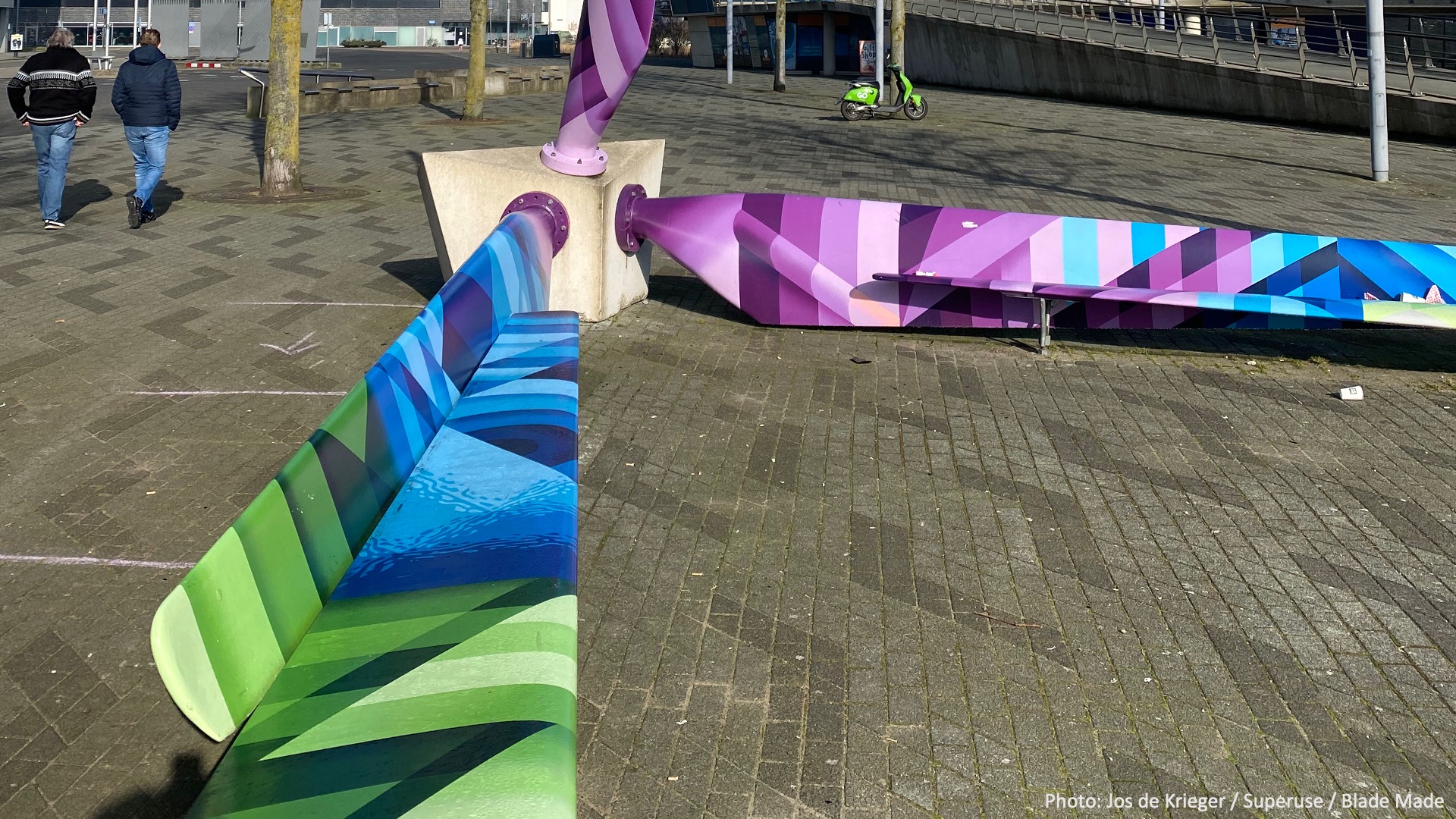
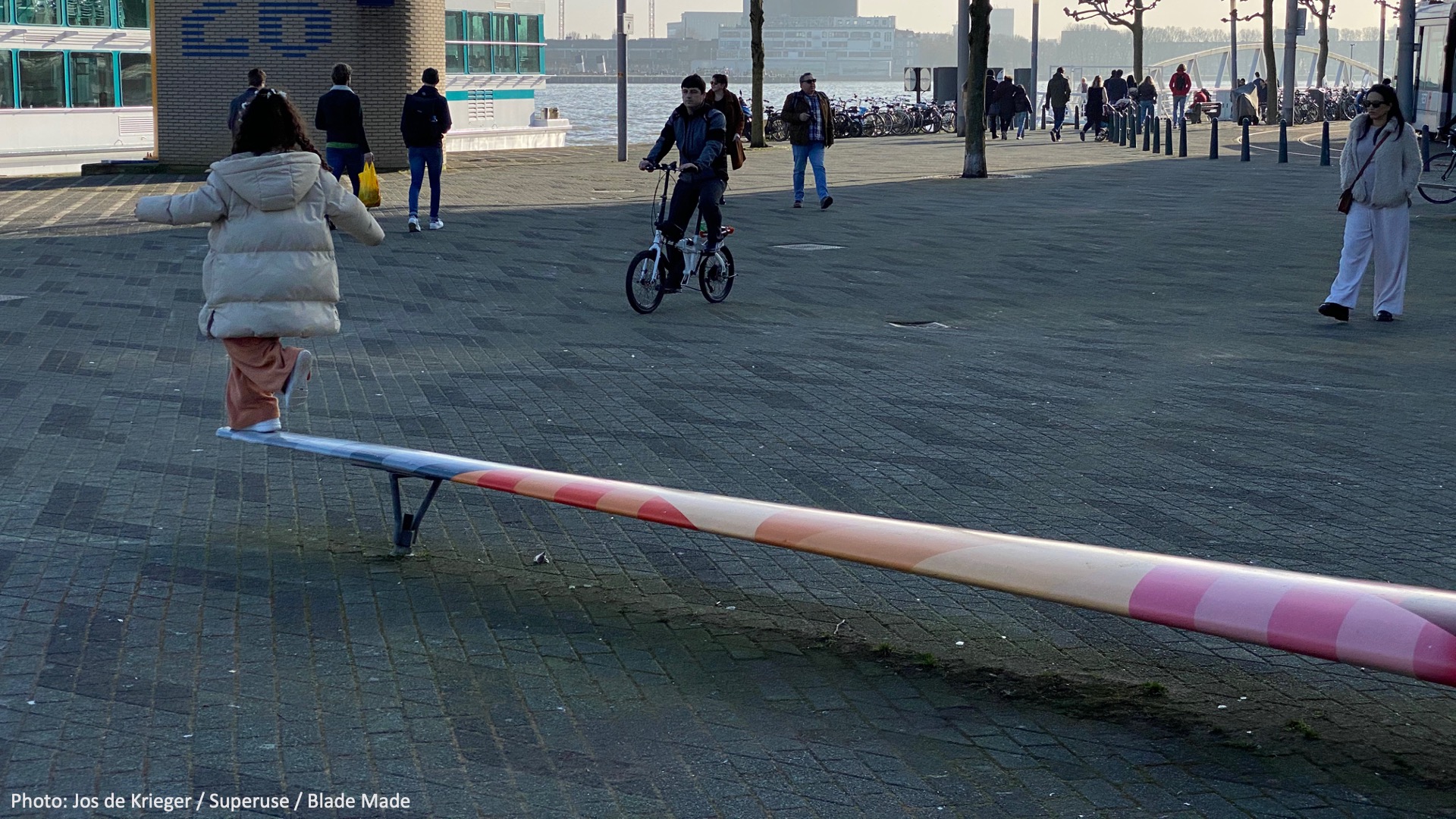
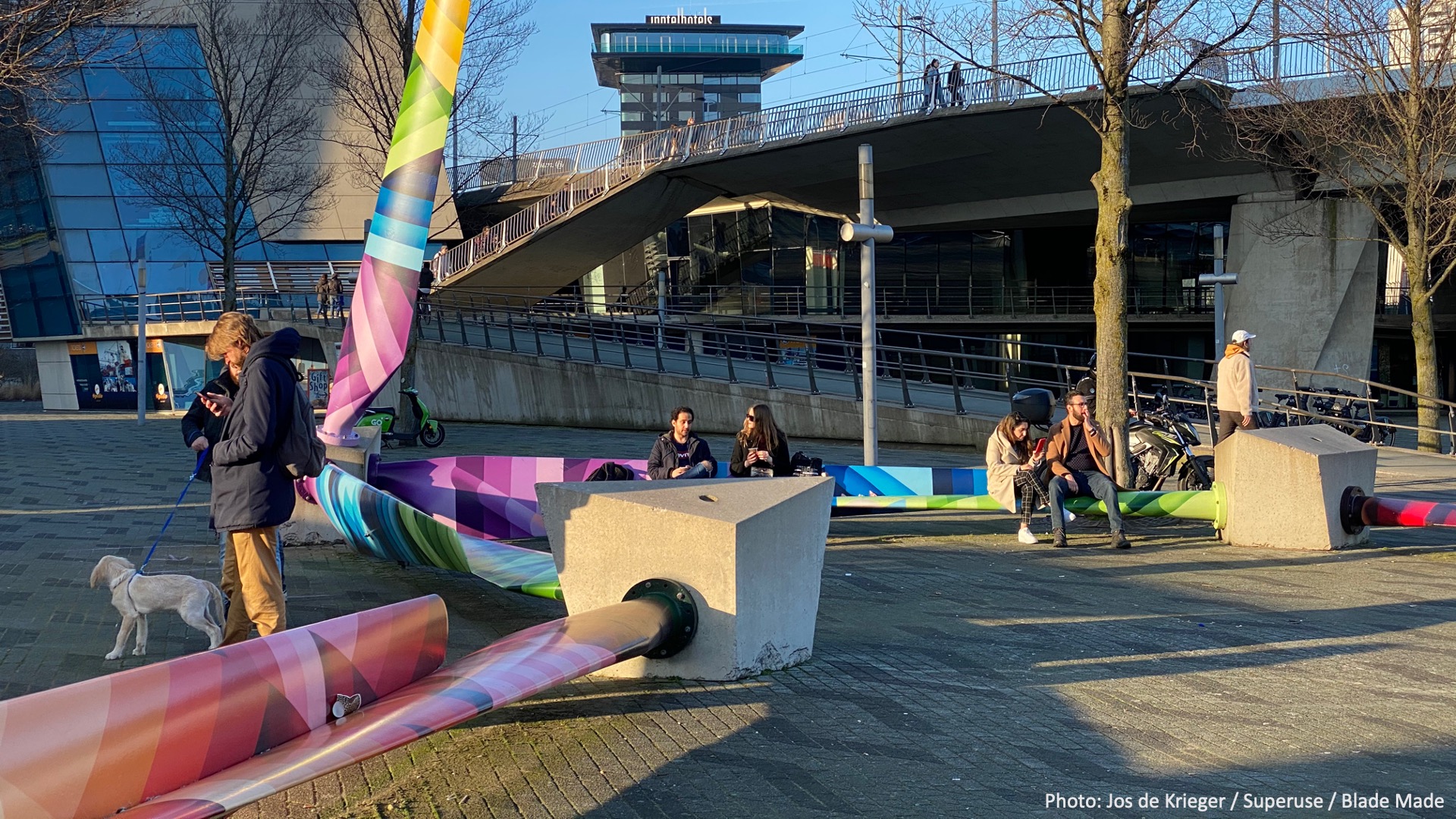
@Superuse Studios, 2020
Content licensed to the European Union.